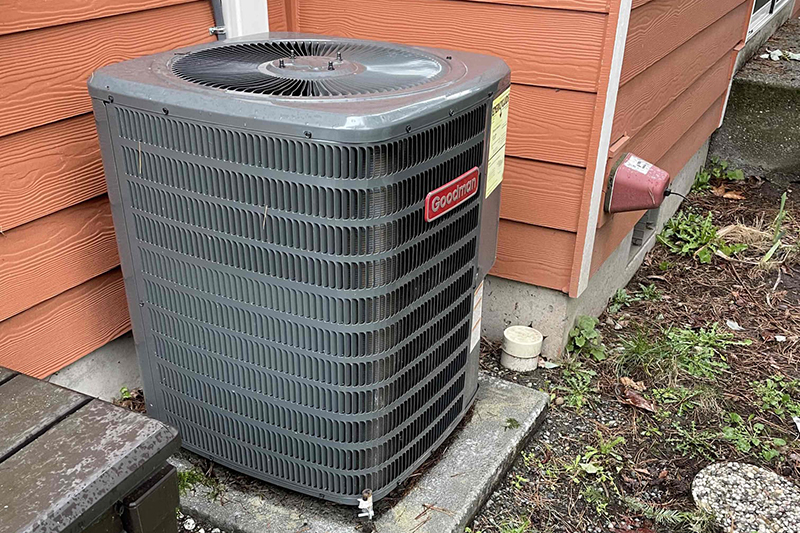How Does Your Central Air Conditioner Cool Your Home?

Unless you’re an HVAC professional—like the team at Lifetime Heating, Cooling, Plumbing & Electric—you probably don’t spend much time thinking about your air conditioner or how it works.
Yet, according to the U.S. Energy Information Administration, about 90% of households in the U.S. use air conditioning. So while you may just care that it keeps your Snohomish, home or business cool, understanding a little more about your system can help you recognize when something’s not working quite right.
Let’s break it down.
A Brief History of AC Technology
Air conditioning has come a long way since its invention in 1902 by Willis Carrier. Originally used to control humidity in a printing facility, the technology quickly made its way into theaters, department stores, and eventually homes.
Today, central air systems are not only more efficient and quieter but often come with smart controls and zoning capabilities. Understanding how your system works empowers you to make smarter decisions about maintenance, upgrades, and repairs.
What Does an Air Conditioner Actually Do?
Your central air conditioner does more than just cool your space. It also:
- Removes humidity from the air by drawing out excess moisture (hence the need for pans and drain lines).
- Improves indoor air quality by pulling allergens and debris out of the air through the filter.
- And of course, it lowers the indoor temperature by removing heat from your home and releasing it outside.
To do all this, most central AC systems use a “split system,” with a hot side (outside unit) and a cool side (inside unit). These two sides work together to extract heat from the air in your home and transfer it outdoors.
Here’s a simplified explanation of how that process works:
- Warm indoor air is drawn into the system.
- The refrigerant inside the system absorbs the heat from the air.
- The heated refrigerant is pumped through a closed-loop system to the outdoor unit.
- A fan blows over the outdoor coil, releasing the heat into the outdoor air.
- The refrigerant cools back down and cycles back inside to absorb more heat.
This heat-transfer process repeats continuously to keep your home comfortable. And while the overall system involves many small moving parts, the core components are what really keep things running.
How Refrigerant Makes Cooling Possible
Refrigerant is the key to your air conditioner’s cooling power. This chemical compound absorbs and carries heat as it circulates through your system. As it evaporates into a gas inside the indoor unit, it draws heat from the surrounding air. When compressed and pushed into the outdoor unit, it releases that heat and condenses back into a liquid.
This cycle of phase changes—from gas to liquid and back again—is what makes modern cooling possible. Maintaining the right refrigerant level is essential. Too much or too little can lead to poor performance, frozen coils, or even compressor failure.
Key Components of a Central Air Conditioner
Of course, your Snohomish, home’s AC system also includes other essential parts—fans, filters, sensors, and more—but these four components are the backbone of your cooling system.
Evaporator (Indoor Unit)
The evaporator is located inside your home on the cool side of the system. It receives the cold, liquid refrigerant. As warm air blows over its chilled coils, the refrigerant absorbs the heat and evaporates into a gas. This process cools the air before it’s circulated back through your home.
Condenser (Outdoor Unit)
The condenser sits outside on the hot side. It works the opposite of the evaporator, converting the refrigerant gas—now carrying heat from your home—back into a liquid. The condenser’s coil releases this heat into the outside air, thanks to a fan that blows across it.
Expansion Valve
The expansion valve is the control center between the condenser and evaporator. It regulates how much refrigerant enters the evaporator. As it removes pressure from the refrigerant, it allows it to expand and turn into a gas, enabling the cooling cycle to restart.
Compressor
The compressor is also located outside and acts like the heart of the system. It pressurizes the refrigerant gas, which raises its temperature and prepares it to release heat once it reaches the condenser coil. The compressor keeps refrigerant circulating through the system in a closed loop.
Boosting Indoor Air Quality With Your AC
Your central air conditioner can do more than cool your home—it can also support cleaner, healthier indoor air. Consider adding indoor air quality products like UV light air purifiers, electrostatic or HEPA filters, or a whole-home dehumidifier.
These upgrades work alongside your HVAC system to reduce allergens, neutralize bacteria and mold spores, and manage excess humidity.
The result? Cleaner air and a more comfortable home environment.
Frequently Asked Questions About Air Conditioners
How often should I service my air conditioner?
We recommend a professional tune-up at least once a year—ideally in the spring before peak cooling season.
Can I clean my AC coils myself?
You can gently rinse your outdoor coil with a garden hose to remove debris, but internal components like the evaporator coil should be cleaned by a licensed technician to avoid damage or voiding your warranty.
Why is my air conditioner running but not cooling?
This could be due to low refrigerant, dirty coils, a malfunctioning compressor, or a blocked air filter. Call a professional for a full system inspection.
Need Air Conditioning Service? Call the Local AC Experts in Snohomish
If your system is blowing warm air, short-cycling, making unusual noises, or driving up your utility bills, it could be time for a repair or tune-up. Routine maintenance helps catch small issues early and keeps your system running efficiently throughout the summer.
Whether you need a quick fix, a full system replacement, or simply want a check-up for peace of mind, our certified HVAC professionals are here to help.
Call Lifetime Heating, Cooling, Plumbing & Electric at 425-200-4999 or request service online to keep your cool all season long.

